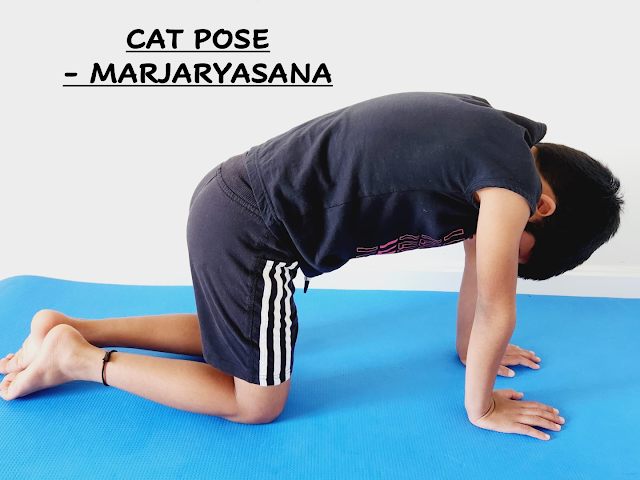KING COBRA POSE - RAJA BHUJANGASANAM
Raja Bhujangasana is King Cobra Pose. Raja means "King" and "Bhujanga" is Cobra. Actually, the word, "Bhuja" is generally translated as "arm" or "shoulder" as in the other common "Bhuja" pose - "Bhujapidasana". And "anga" means "limb".
But I'm not sure how you would get "cobra" from that. In any case, Bhujangasana is said to look like a cobra with its head raised, and Raja Bhujangasana is just the fullest expression. But touching one's feet to one's head is not the fullest expression of the pose - putting one's toes up one's nose is! But I have seen young kids do something along those lines. Between, kids generally have amazing back flexibility and not so good forward bending capability, whereas adults tend to have the opposite.
It is not recommended to do King Cobra before you feel pretty comfortable in regular Cobra Pose and not everyone does. That is why there are various modifications for Cobra, including low cobra, No cobra, half cobra, sphinx and so on. A great counterpose is Balasana, child's pose.
There are many many stories in the yoga tradition involving snakes. One of my favorites is about a snake who is terrorizing a village. A great swami comes to town one day and teaches the snake a mantra, telling him not to bother the village people anymore. A year or so later the swami returns to find the snake cowering in its hole, bruised and beaten. The snake tells him that he had been faithfully doing his mantra, but the village children beat him up when they saw that he was not retaliating at all. The swami then informed him that while he told him not to bite anyone, he never told him not to hiss! The point being that sometimes we do need to stand our ground and not back down, all the while coming from love and refraining from violence.
HOW TO DO
- start on your tummy, in what's known as a prone position, rest your forehead on the mat
- take your palms to the mat beneath your shoulders and spread your fingers nice and wide
- take your shoulder blades down your back towards your hips while you squeeze or cuddle your elbows into your ribs
- press firmly into the mat with the tops of your feet, and the pubic bone
- inhale and push the top of the head forward and lift your chest of the mat into baby cobra
- if that's comfortable, engage the abdominals. take the navel in towards your spine to protect your lower back. Start to press through the hands and using your back muscles lift further toward the sky. Straighten the arms
- if you'd like to intensify the backbend even further into King Cobra, slowly lower to starting position, Spread the legs so the knees reach toward the edges of the mat. Using the same process as outlined above, press into the earth and lift the torso off the mat
- reach your head high and then take the bend into your neck
- bend the knees and take the toes towards your head and the center of the mat
- stay for a few breaths and lower slowly, the same way you came into the pose
In addition to providing a strong backbend, king cobra pose offers a deep stretch of the quadriceps, the chest, shoulders and throat. It also has these benefits in common with cobra pose:
- reduces stress, anxiety and mild depression
- tones and firms the gluteus muscles
- oxygenates the blood and improves circulation
- stimulates the internal abdominal organs and improves digestion
- improves lung function
- stretches and strengthens the spine
- improves symptoms of respiratory conditions such as asthma
- eases menstrual discomfort
- opens the heart and throat chakras
- Beginners : 10 - 20 seconds
- Intermediate : 20 - 40 seconds
- Advanced: 1 minute
CONTRADICTIONS
While Raja Bhujangasana can offer several benefits, there are certain contradictions and precautions to consider before practicing this pose. It's important to be aware of these to avoid any potential risks or discomfort. Here are some contradictions for raja bhujangasana.
- avoid practicing raja bhujangasana during pregnancy, especially during the second or third trimesters. It puts pressure on the abdomen and many not be suitable for the changing body
- individual with chronic or acute back or neck injuries, such as herniated discs, should avoid this pose or modify it with the guidance of a qualified yoga teacher
- if you have undergone abdominal surgery recently, it is best to avoid this pose until you have fully recovered. the pressure on the abdomen in raja bhujangasana can strain the healing tissues
- if you have uncontrolled high blood pressure, it is advisable to avoid deep backbends like raja bhujangasana. These poses can elevate blood pressure levels further and may not be suitable for individuals with hypertension
- some individuals may experience increased pressure in the head or aggravation of migraines or headaches during backbends. if you are prone to such conditions, approach raja bhujangasana cautiously or avoid it altogether



























0 Comments